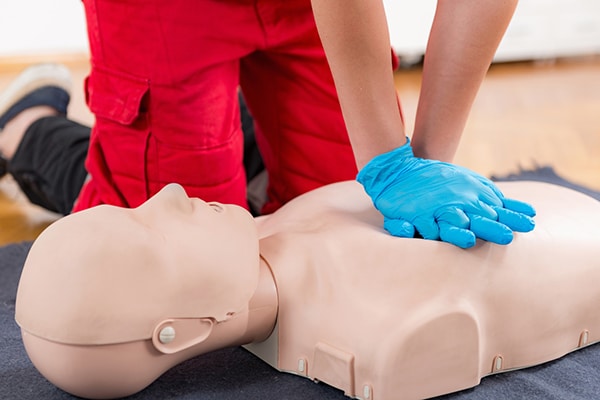— Train With The Best
CPR Training
HLTAID009:
CPR Training
This unit applies to all workers who may be required to provide CPR, in a range of situations, including community and workplace settings.
Specific licensing /regulatory requirements relating to this competency, including requirements for refresher training should be obtained from the relevant national/state/territory Work Health and Safety Regulatory Authorities.

Course Specifications
| ELEMENT | PERFORMANCE CRITERIA |
| Elements define the essential outcomes. | Performance criteria specify the level of performance needed to demonstrate achievement of the element. |
| 1. Respond to an emergency situation |
1.1. Recognise and assess an emergency situation. 1.2. Ensure safety for self, bystanders and casualty. 1.3. Assess the casualty and recognise the need for cardiopulmonary resuscitation (CPR). 1.4. Seek assistance from emergency services. |
| 2. Perform CPR procedures |
2.1. Perform CPR in accordance with the ARC guidelines. 2.2. Display respectful behaviour towards casualty. 2.3. Operate an automated external defibrillator (AED) according to manufacturers’ instructions. |
| 3. Communicate details of the incident |
3.1. Accurately convey incident details to emergency services. 3.2. Report details of incident in line with appropriate workplace or site procedures. 3.3. Maintain privacy and confidentiality of information in line with statutory or organisational policies. |
| 4. Review the incident |
4.1. Recognise the possible psychological impacts on self and other rescuers and seek help when required. 4.2. Contribute to a review of the first aid response as required. |
The Foundation Skills describe those required skills (language, literacy, numeracy and employment skills) that are essential to performance.
Foundation skills essential to performance are explicit in the performance criteria of this unit of competency.
Evidence of the ability to complete tasks outlined in elements and performance criteria of this unit in the context of the workplace or community setting.
There must be evidence that the candidate has completed the following tasks in line with State/Territory regulations, first aid codes of practice, first aid guidelines determined by the Australian Resuscitation Council (ARC) and other Australian national peak clinical bodies and workplace or site procedures:
managed, in line with ARC guidelines, the unconscious, breathing casualty including appropriate positioning to reduce the risk of airway compromise
managed, in line with ARC guidelines, the unconscious, non-breathing adult, including:
- performing at least 2 minutes of uninterrupted single rescuer cardiopulmonary resuscitation (CPR) (5 cycles of both compressions and ventilations) on an adult resuscitation manikin placed on the floor
- following the prompts of an automated external defibrillator (AED) to deliver at least one shock
- demonstrating a rotation of single rescuer operators with minimal interruptions to compressions
- responding appropriately in the event of regurgitation or vomiting
- handing over to emergency services
- providing an accurate verbal report of the incident
- reviewing the incident
managed, in line with ARC guidelines, the unconscious, non-breathing infant, including:
- performing at least 2 minutes of uninterrupted single rescuer CPR (5 cycles both compressions and ventilations) on an infant resuscitation manikin placed on a firm surface.
Demonstrated knowledge required to complete the tasks outlined in elements and performance criteria of this unit:
guidelines and procedures including:
- relevant ARC guidelines to managing the unconscious breathing and non-breathing casualty and provision of CPR
- potential incident hazards and risk minimisation processes when providing first aid
- infection control procedures, including use of standard precautions and resuscitation barrier devices
- requirements for currency of skill and knowledge
- first aid codes of practice
- appropriate workplace or site procedures relevant to the provision of first aid
legal, workplace and community considerations, including:
- duty of care requirements
- own skills and limitations
- consent and how it relates to the conscious and unconscious casualty
- privacy and confidentiality requirements
- awareness of potential need for stress management techniques and available support for rescuers
considerations when providing CPR, including:
- upper airway and effect of positional change
- appropriate duration and cessation of CPR
- appropriate use of an AED
- safety and maintenance procedures for an AED
- chain of survival
- how to access emergency services
techniques for providing CPR to adults, children and infants including:
- how to recognise that a casualty is unconscious and not breathing normally
- rate, ratio and depth of compressions and ventilations
- correct hand positioning for compressions
- basic anatomy, physiology and the differences between adults, children and infants relating to CPR.
Each candidate to demonstrate skills in an environment that provides realistic in-depth, scenarios and simulations to assess candidates’ skills and knowledge.
Due to the nature of this type of training, it is acceptable for the performance evidence to be collected in a simulated environment.
Compression and ventilation skills must be demonstrated on resuscitation manikins following ARC guidelines for the purpose of assessment of CPR procedures.
Assessment must ensure access to:
- adult and infant resuscitation manikins following ARC guidelines for the purpose of assessment of CPR procedures
- AED training devices
- personal protective equipment (PPE).
Simulated assessment environments must simulate real-life situations where these skills and knowledge would be performed, with all the relevant equipment and resources of that workplace or community environment.
Assessors must satisfy the Standards for Registered Training Organisations’ requirements for assessors and must hold this unit or demonstrate equivalent skills and knowledge to that contained within this unit.
Please contact our office for any details.
For more information on pricing contact PTA
Contact Details:
Telephone: (02) 4040 1788
Email: precisiontrainingacad@gmail.com

Our Local Trainers and Assessors
At Precision Training Academy our Trainers and Assessors are fully qualified and licensed for all courses being delivered on our scope of registration.
All of our courses are regularly updated and revised, ensuring they comply with the latest regulatory and industry standards.
Sonya and Darren are also qualified firearm instructors and maintain their currency of security industry experience with Precision Protection Group.
Sonya Pritchard and Darren Upson are also the proprietors of Precision Protection Group, a local Newcastle based security company which is a fully qualified, licensed and experienced company.
Precision Training Academy is a Registered Training Organisation (RTO) approved by the Australian Skills Quality Authority (ASQA), our RTO Code is 31555, details of our organisation can be found on training.gov.au.
